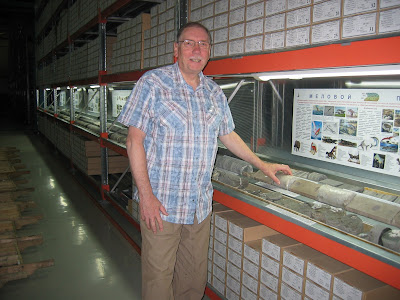
Picture: Touching the newly placed Gagarin Stone set along the Skara Brae timeline in April of this year
After such collaborative success I was invited by Ugra's Governor, Mr. Alexander Filipenko, to visit the region at my earliest opportunity. Two 3 hour flights from London later and I was there. It would be 5 hours if you flew direct to reach beyond the Urals into the oil and gas rich plains of Western Siberia.

Picture: A dubious character (RG) in Moscow's Red Square
I previously met the deputy governor Oleg Goncharov in Orkney during our time working on the stone's commemoration. I have had face to face meetings with Governor Filipenko and also with his deputy chairman of government issues of Investment and Innovations, Mr Morozov (Mr Frosty - in literal translation, though he was far from that).
In Ugra there are one and a half million inhabitants living in an area the size of France. 25,000 are native Khanty-Mansiysk people who still live a traditional lifestyle to some extent. The attraction from the late Soveit times was oil. This area has helped transform the modern Russian economy. The pumping heart of the economic boom is westerm Siberia's oil fields, which produce around 70% of Russia's oil - some 7 million barrels per day. Western Siberia, it turns out, had even more oil than anyone could have imagined: more than 70 billion barrels have been pumped over the past 40 years.

Picture: Core samples in the Kern Museum KM where oil deposits are mapped
Mr Filipenko's latest project is the redevelopment of the provincial capital Khanty-Mansiysk, a town of 60,000. The province's oil industry generates $40 billion in annual tax revenues, $4.5 billion of which Khanty-Mansi gets to keep for its own use - the rest goes to Moscow. Khanty-Mansi therefore, has an unparalleled opportunity to create modern and desirable living conditions in a region otherwise thought of as harsh and desolate.

Above: The Well Being Hotel in Khanty-Mansiysk. A perfect example of the remarkable redevelopment going forward.

Above: A fountain in KM with one of our camera men - a film of our journey will be shown on Russian Hour TV in September
The Russian Federation has benefited hugely from such profitable soil and the area has been able to buck the trend of falling populations. Unlike the country as a whole, whose population is in decline, Khanty-Mansi's has increased 18 percent since 1989. It has been subject to major social investment using oil and gas profits to build a broader and more attractive economy for the future.
Despite his party background, Mr Filipenko's vision is distinctly non-Soviet. The capital's leading architectural symbols include a shomping emporium toppoed by a giang green dome in the shame of a chum, the traditional tent used by the region's indigenous people - the Khanty, Mansi, and others who hunt, fish and herd. Such symbolism was unthinkable in Soviet times when the state denied the very idea of culturally derived identity.

Picture: With Lenin, the Czar and Orkney friends Bob Mimmer and Helen
Mr Filipenko has been able to identify the myriad political, economic, and technical challenges looming on the horizon when the monetarily rich oil injections some day dry up. Today, Ugra takes second place to Moscow on volume of capital investments, and what's more, it has the best standards of living in Russia with top salaries, state of the art nursery, hospitol and recreational facilities. My series of informal meetings and visits to facilities and cultural, health and educational institutions shows how Mr Filipenko has been able to create a vitally modern city, about the size of Inverness, from a Siberian oil camp.

